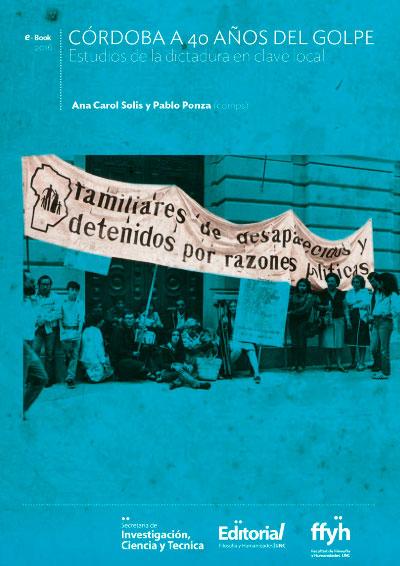Córdoba 40 years after the coup: studies of the dictatorship from a local perspective
Keywords:
History of Córdoba (Argentina) - 1976-1983, Córdoba (Argentina) - political and social, conditions - 20th century, coup d'état - Argentina (1976-1983) - consequences in Córdoba, military dictatorship - 1976-1983 - local studies, state terrorism, political repression, political violence, press and dictatorship, human rights - violations, historical memorySynopsis
On the occasion of the fortieth anniversary of the last and most fateful coup d'état perpetrated in Argentina, some professors of Contemporary Argentine History at the Faculty of Communication Sciences, National University of Córdoba, considered it appropriate to publish a book that would bring together a series of scattered studies on the themes of Córdoba and dictatorship.
Originally, the central idea was to produce a text that would address research concerns on topics from the recent past with a strong territorial anchor, reflecting the unique characteristics that differentiate us from the rest of the country. With this in mind, and in order to enrich the project, various individuals who had been working on related topics were invited to contribute their insights and expertise. Although, for various reasons, not everyone was able to participate, eight research projects were coordinated that express the main lines of debate and historical inquiry on the subject.
This book brings together eight chapters grouped into four sections that reflect experiences of militancy, repression, the press, and continuities between the dictatorship and the present.
First, the concern for bringing together the reconstruction of the universe of those who suffered reprisals and studies of militancy is integrated into the chapter by Alicia Servetto and Ana Noguera dedicated to constructing a profile of the militants of the armed revolutionary organizations of Córdoba.
Secondly, from a counterrevolutionary perspective, Eliana Lacombe's chapter analyzes the so-called Marxist infiltration as a political-religious enemy.
Thirdly, regarding the broad and diverse debate that has been taking place in recent years about the armed struggle and, in particular, about the militaristic deviations of some left-wing organizations, Gabriel Montali analyzes the political and military action of the Communist Organization Workers' Power (OCPO), which in Córdoba—between 1974 and 1976—became the third most important revolutionary organization behind Montoneros and the PRT-ERP.
Fourthly, and in relation to union activism, Ana Elisa Arriaga presents an overview of the impact of violence and state repression among electrical workers in Córdoba, addressing both the progressive loss of collective rights in terms of the weakening of their capacity for union action and the curtailment of individual labor rights.
Fifth, based on the murder of nine university students in Córdoba in early December 1975, Melisa Paiaro focuses on the formation and actions of the self-styled Comando Libertadores de América (Liberators of America Command).
Sixth, regarding violence suffered in the field of social communication, Pablo Ponza and José Soaje examine the continuity and rupture of repressive actions against journalists and the print media in Córdoba, based on the unique political scenario that began with the Navarrazo.
Seventh, in the field of human rights, Ana Carol Solis explores the ways in which the press did or did not favor the creation of an alternative common sense regarding reports of violations committed, one that was supportive of the cause of the victims of reprisals, their families, and their loved ones.
Eighth and last, Marta Philp investigates how the dictatorship based its actions on key ideas about the political order, the role of different social sectors, and Argentina's place in the world.
Libertadores de América Command.
Chapters
-
Introduction
-
From “guerrillas and subversives.” Towards a profile of the militants of the armed revolutionary organizations of Córdoba, Argentina
-
Marxist infiltration in the Argentine church. Construction of Third Worldism as a political-religious enemy from the counterrevolutionary perspective
-
Strategy and tactics in the Argentine revolutionary left
-
Union repression and labor disciplineviolence in the conflict control mechanism at EPEC (1973-1978)
-
Exhibiting terror. The Liberators of America Commandbetween political assassination and the restoration of honor
-
Repression and the print media in Córdoba
-
Show, hide, and disengage in the face of state terror. The press and the issue of human rights in Córdoba, 1976 and 1979
-
The natural order as a strength. Continuities and ruptures in the ideological foundations of the dictatorship

Downloads
Published
Categories
License

This work is licensed under a Creative Commons Attribution-NonCommercial-ShareAlike 4.0 International License.


